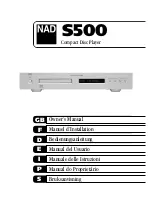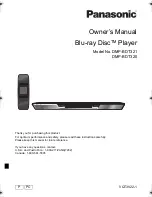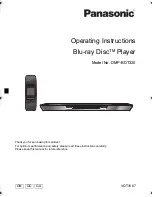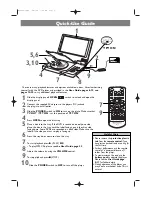
89
Add
iti
on
al
I
n
fo
rm
at
io
n
GB, a single-layer and double-sided DVD is
9.4 GB, and double-layer and double-sided
DVD is 17GB.
The picture data uses the MPEG 2 format, one
of the worldwide standards of digital
compression technology. The picture data is
compressed to about 1/40 (average) of its
original size. The DVD also uses a variable
rate coding technology that changes the data
to be allocated according to the status of the
picture. Audio information is recorded in a
multi-channel format, such as Dolby Digital,
allowing you to enjoy a more real audio
presence.
Furthermore, various advanced functions
such as the multi-angle, multilingual, and
Parental Control functions are provided with
the DVD.
DVD-RW (page 6)
A DVD-RW is a recordable and rewritable
disc that is the same size as a DVD VIDEO.
The DVD-RW has two different modes: VR
mode and Video mode. DVD-RWs created in
Video mode have the same format as a DVD
VIDEO, while discs created in VR (Video
Recordings) mode allow the contents to be
programmed or edited.
DVD+RW (page 6)
A DVD+RW (plus RW) is a recordable and
rewrtitable disc. DVD+RWs use a recording
format that is comparable to the DVD VIDEO
format.
Film based software, Video based
software (page 62)
DVDs can be classified as Film based or
Video based software. Film based DVDs
contain the same images (24 frames per
second) that are shown at movie theatres.
Video based DVDs, such as television
dramas or sit-coms, displays images at 25
frames (or 50 fields) per second.
Index (CD)/Video Index (VIDEO CD) (page
9)
A number that divides a track into sections to
easily locate the point you want on a CD or
VIDEO CD. Depending on the disc, no index
may be recorded.
Interlace format (page 77)
Interlace format shows every other line of an
image as a single “field” and is the standard
method for displaying images on television.
The even number field shows the even
numbered lines of an image, and the odd
numbered field shows the odd numbered lines
of an image.
International standard coding system used to
compress audio digital signals authorized by
ISO/IEC. MPEG 1 conforms to up to 2-
channel stereo. MPEG 2, used on DVDs,
conforms to up to 7.1-channel surround.
Progressive conversion method (PAL)
(page 62)
• Video based software conversion
Video shows an image by alternately
displaying every other line of an image (field)
at 25 frames (50 fields) per second (Interlace
format).
The Interlace format displays 25 frames (50
fields) per second by displaying every other
line of the image, causing scanning lines to
appear across the image. Furthermore, since
only half of the image is shown at once, the
amount of information contained in an image
is limited.
The Progressive format displays 50 entire
frames per second. The player accomplishes
this by converting each field into a frame by
using either a field-based conversion method
or a frame-based conversion method. The
appropriate method is automatically selected
by the player according to the movement of
the images on the screen. If the movement on
the screen is slow, the frame-based
conversion method borrows adjacent field
information to fill in the missing information.
If the movement on the screen is rapid, the
field-based conversion method creates the
missing information by predicting the
movement of the images on the screen from
,
continued








































